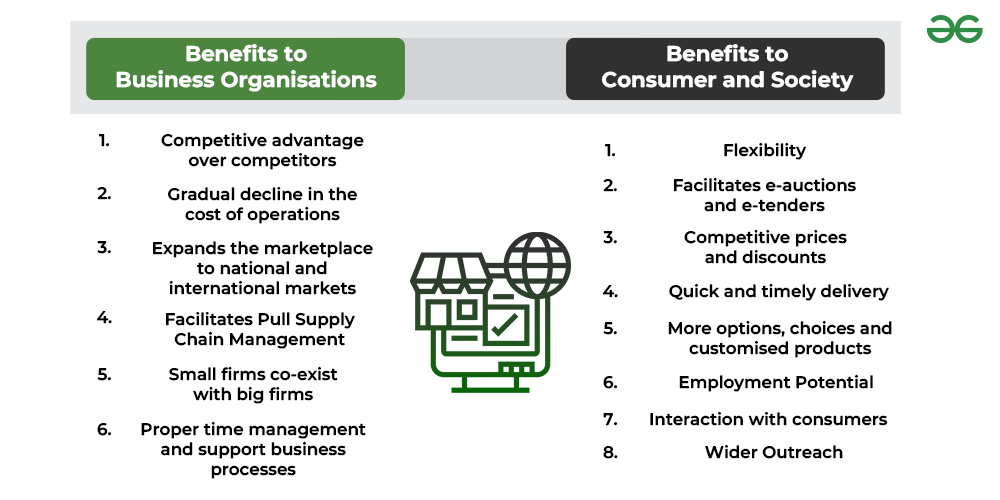Benefits of E-commerce
Last Updated :
07 Feb, 2024
What is E-commerce?
E-commerce, also known as Electronic Commerce, refers to the purchase and sale of goods and services through the Internet. The first online transaction occurred in 1994 when a guy sold a Sting CD to a friend via his website Net Market, an American retail platform. This is the first case of a consumer purchasing a product from a business over the World Wide Web, sometimes known as e-commerce. After that, e-commerce evolved to make it easier to locate and purchase products through online merchants and marketplaces.
E-commerce is supported by technology assets such as supply chain management, internet marketing, online transaction processing, a data management system, and an inventory management system. Not only that, even live chats, chatbots, and voice assistants all empowered e-commerce. E-commerce is defined as the execution of business on an online platform using digital devices, such as mobile phones, computers, tablets, and the internet.
Benefits of E-commerce
E-commerce provides different benefits to Business Organisations, and Consumers and Society.

Benefits of E-commerce to Business Organisations:
1. It gives a competitive advantage over competitors.
2. It helps business organisations by gradually declining the cost of operations.
3. It also expands the marketplace to national and international markets.
4. It also facilitates Pull Supply Chain Management. Pull Strategy means following a just-in-time inventory management technique under which the organisation enters the products into the supply chain only when the customer demand justifies it.
5. Because of e-commerce, small and big firms co-exist in the market.
6. It also enables proper time management and supports business processes.
Benefits of E-commerce to Consumer and Society:
1. It brings flexibility to the customers.
2. e-commerce also facilitates e-auctions and e-tenders.
3. It helps customers by providing them with competitive prices and discounts.
4. It provides quick and timely delivery to customers.
5. It provides consumers with more options, choices, and customised products.
6. It also brings employment potential to society.
7. Through e-commerce, businesses can interact with their customers.
8. Ultimately, it gives wider outreach to the consumers.
Types of E-commerce
1. B2B Commerce
Both parties involved in e-commerce transactions are business firms, hence the name B2B, which stands for business-to-business.
The creation of utilities or the delivery of value requires the interaction of a business with a number of other business firms, which may be suppliers or vendors of various inputs, or they may be a part of the channel through which a firm distributes its products to consumers. For example, the production of an automobile requires the assembly of a large number of components, which are manufactured elsewhere, either locally or overseas.
2. B2C Commerce
B2C (business-to-customers) transactions involve business firms on one end and their customers on the other. Although online shopping is the first thing that comes to mind, it is important to remember that selling is the outcome of the marketing process. Marketing begins before a product is offered for sale and continues after the product is sold. As a result, B2C commerce entails a wide range of marketing activities such as identifying activities, promoting, and sometimes even delivering products that are carried out online.
3. C2C Commerce
C2C Commerce consists of the transactions taking place between two or more customers. For example, you could sell used books or clothes for cash or in exchange for goods. People can search for potential buyers all over the world because of e-commerce. Quikr, OLX, are such platforms where customers sell their goods and services to other customers.
4. Intra B-Commerce
The interaction and dealing among various departments and persons within the firm is known as Intra B-Commerce. An intranet is used to interact and deal between various departments and firms within a firm. Intra B-Commerce has facilitated flexible manufacturing. For example, finance department may interact regularly with marketing department within a firm.
Like Article
Suggest improvement
Share your thoughts in the comments
Please Login to comment...